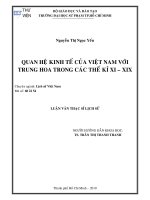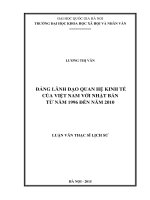Quản trị kinh doanh luôn là một trong những ngành hấp dẫn các bạn trẻ năng động, đặc biệt trong xu thế hội nhập kinh tế Quốc tế của Việt Nam những năm gần đây. Việc tìm hiểu rõ về ngành Quản trị kinh doanh giúp bạn định hướng nghề nghiệp tốt hơn trước kh
Bạn đang xem bản rút gọn của tài liệu. Xem và tải ngay bản đầy đủ của tài liệu tại đây (1.12 MB, 15 trang )
Chapter 15
Designing and Leading a Learning
Organization
1
Chapter Objectives
Trace the evolution of leadership through four eras to the
learning leadership required in many organizations today.
Recognize how leaders build learning organizations through
changes in structure, tasks, systems, strategy, and culture.
Know when and how horizontally organized structures
provide advantages over vertical, functionally organized
ones.
Distinguish between tasks and roles and how each impacts
employee satisfaction and organizational performance.
Meet the dual challenge of supporting both efficiency and
learning by using ambidextrous organization design
elements, embracing technology, and using after-action
reviews.
2
Ex. 15.1 Leadership
Evolution
Micro
Scope
ENVIRONMENT
Stable
Chaotic
Era 2
Rational Management
Era 3
Team Leadership
•Behavior theories
•Contingency theories
Setting:
•Vertical hierarchy,
bureaucracy
•Management functions
Era 1
Great Man Leadership
•Trait theories
Setting:
•Pre-bureaucratic organization
•Administrative principles
Macro
•Confusion
•Empowerment
•Quality
Setting:
•Horizontal
organization
•Cross-functional
teams
•DownsizingEra 4
Learning Leadership
•Shared vision, alignment,
relationships
•Facilitate change and
adaptation
Setting:
•Learning organization
•E-Business
3
Learning
A change in behavior or
performance that occurs as a
result of experience
4
Adaptive Learning Cycle
A cycle of action, feedback,
and synthesis that all living
organisms share
5
Ex. 15.2 The Adaptive Learning
Cycle
Action
De
ci d
i ng
i ng
ns
Se
Feedback
Synthesis
Learning
6
Learning Organization
One in which everyone is
engaged in identifying
and solving problems
7
Ex. 15.3 Two Models of
Organization
Efficient Performance
(Hard, rational model)
Vertical
Structure
Rigid
culture
Routine tasks
Formal
systems
Competitive
strategy
8
Ex. 15.3(contd.)
Learning
Organization
(Soft, intuitive model)
Horizontal
structure
Adaptive
culture
Empowered
roles
Personal
networks
Collaborative
strategy
9
Ex. 15.4 Evolution of Vertical to Horizontal Structure
A.
Vertical functional organization
B.
Functional organization with
process overlays
10
Ex. 15.4 (contd.)
C.
Horizontal organization based
on processes
11
Tasks Versus Roles
Task: a narrowly defined work
assignment
Role: a part in a social system
12
Ex. 15.5 An Organizational
Communication Network (adapted)
Marketing
Manufacturing
Engineering
David
Sharon
13
Ambidextrous Organizations
Flexible organizations in which
leaders incorporate structures and
management processes that are
appropriate to innovation and
learning, as well as to the efficient
implementation of ideas
14
Knowledge Management
The efforts to systematically gather
knowledge, make it widely available,
and foster a culture of collaboration
and learning
15









